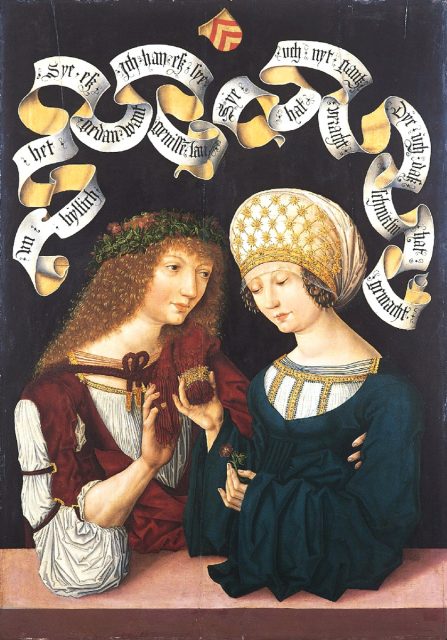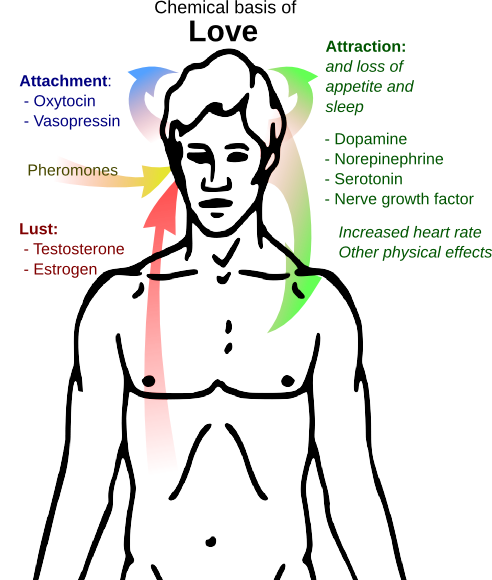The chemistry of love revealed

If you were told something like “there is chemistry between us”, you certainly would not think that the speaker is referring to actual molecules flying across the space but, more appropriately, you would take it as a figurative way of talking. However, the saying turns to be more literal than it may seem: there is a big deal of biochemistry going on in our brain, responsible for the many effects of what is commonly called romantic love.
Neurobiologists, in a curious and rather indiscreet attempt to dismantle the mysteries of love, have used fMRI techniques to “look inside” our thoughts and see what kind of processes and activities occur inside a brain in love. Anthropologist Helen Fisher has devoted many years of her research to study the brain of people in love. In one of her experiments, people who claimed being deeply in love were given photographs of their beloved ones while their brain activity was being monitored 1. The results from the fMRI images were conclusive: there is activity in the right ventral tegmental area (VTA) and in the right caudate nucleus. These regions belong to the so called reptilian brain, far below our cognitive process, and they form the core area of our reward system.
The VTA is a region rich in dopamine, one of the neurotransmitter in our brain. Drives, or neural states that direct behaviour to acquire a particular biological need, are associated with dopamine activity. Drives impinge in the subjects a state of wanting, motivation and focus. Brain studies have shown that romantic love is a particular example where the reward system of the individual brings up a dopamine-filled brain, motivated, desiring and focused on the beloved one. Dopamine also produces feelings of euphoria and happiness, comparable to a high of cocaine (where high concentrations of this neurotransmitter are also predominant) and, like the drug, love is able to create dependence. In fact, love has all characteristics of any addition: tolerance (increased doses needed to achieve desired effects); physical dependence (withdrawal syndrome upon termination); and relapse following abstinence. The effects of dopamine in the brain turn us literally addicted to love. It is curious to think that any legal affair would be considered null if signed under drugs effect, but two people in love, with their minds driven by dopamine, are actually encouraged to close a marriage contract for life.
Next to the craving, euphoria and focus resulting from the dopamine action, the brain goes into an obsessive behavior, which has been linked to decreasing serotonin levels. Psychiatrist D. Marazitti from the University of Pisa measured the serotonin levels of patients with obsessive-compulsive disorder and of people deeply in love and found that both groups presented comparable low levels 2. From this perspective, there is no sharp cut between love and mental illness. Some other “love symptoms” become understood by looking at some of the serotonin functions, such as the regulation of mood, appetite and sleep cycles. Interestingly, Helen Fisher suggests that the ingestion of antidepressants, rich in serotonin, puts in danger the capability of loving 3.
Results from the fMRI experiments also indicate less activity of the frontal cortex area 4. The frontal cortex is the latest region evolutionary speaking and distinguishes humans and some other mammals from the rest of the species. Among many other high-level functions, the frontal cortex helps us to express judgments about other people. In other words, what these results come to tell is that there is no place for assessments about the beloved one and judgments are basically suppressed. On this basis, one can assure that blind love really exists and, to my view, it is a pragmatic and indispensable approach to make us find in a feasible manner our perfect partner.
Certainly a brain doped with dopamine and obsessed is far from being productive. In any case, it is not the best option to look after a baby, should one enter into the picture. The initial phase of euphoria and obsession is followed by a period where bonding and attachment take the lead. It has been suggested that after some time, the brain develops tolerance to dopamine and the initial shots turn later not to reach the threshold for the high. Putting it in biochemical terms, the dopamine effects are suppressed and oxytocin, vasopressin and endorphins take over. The oxytocin induces the feeling of connection and attachment to others and researchers have related this hormone to monogamy. In an experiment with Prairie vole, a monogamous type of mouse which has high levels of oxytocin in blood, the blockage of oxytocin receptors would suppress the idiosyncrasy of this species of mating for life 5. Likewise, oxytocin would be also responsible for monogamy in human kind. The endorphins, in turn, give the feelings of safety, tranquility, and peace, which bring stability into the couple.

Love, at least in physiological terms, will come to an end when the levels of oxytocin deplete. More precisely, after approximately four years the bonding becomes weaker, a time frame that would ensure parental protection to a new born. Related or not, the fact is that the number of divorces has a peak after the fourth relation year 6. If one wishes to maintain a long-term relationship, a good piece of advice thus is to keep active the oxytocin production, being it released among others by skin contact and during orgasm (for the record). Nevertheless, the landscape about long-term love seems to be more optimistic than that. Scientists have applied fMRI techniques to measure the brain activity of subjects in long-term relationships 7 and found that the same reward areas linked to motivation that were active in the early stage of romantic love are still sustained during later phases. The attachment and bonding, characteristic of a long-term relationship, coexist with feelings of wanting and longing, features of romantic love.
One might wonder whether a long-lasting relationship would not also be encouraged from the very beginning by choosing a well-matched life partner. But, how it all begins? How we come to feel butterflies in the stomach in somebody’s presence? The answer is, as one can imagine, not trivial and there are numerous factors influencing mate choice, but chemistry seems to be involved here again. In an experiment carried out by the Swiss zoologist Claus Wedekind, the odorous pheromones that we transpire seemed to dictate the information required for partner choice in a group of humans 8. In the experiment, a group of women was asked to rate the scent of T-shirts worn by some men. The women rated more pleasant the odour of those men who happened to have an immune system different from hers. Such a choice favors those couples to improve the genetic resistance to external organisms in their offspring. This experiment might give a hint to trust our gut feeling (at least a bit more), although the question on why this person and not that other still remains open.
There are surely large differences in the cultural concept of love worldwide. However, the biochemistry of romantic love seems to be universal, effective and well-defined. The result is that these neurotransmitters, hormones and molecules steer us, humans, with the only aim of continuing our kind, into a chaos of desires, suffering and joy, in some occasions more pleasant than in others. I guess we have no choice but letting the chemistry and feelings flow, even if only for the sake of our species.
References
- H.Fisher, A. Aron, L. Brown, “Romantic Love: An fMRI Study of a Neural Mechanism for Mate Choice”, The Journal of Comparative Neurology 493:58-62 (2005) ↩
- D. Marazziti, H.S. Akiskal, A. Rossi & G.B. Cassano, “Alteration of the platelet serotonin transporter in romantic love”, Psychological Medicine, 29,741–745, (1999) ↩
- Fisher, H and JA Thomson Jr., “Lust, Romance, Attraction, Attachment: Do the side-effects of serotonin-enhancing antidepressants jeopardize romantic love, marriage and fertility?” Evolutionary Cognitive Neuroscience. SM Platek, JP Keenan and TK Shakelford (Eds.). Cambridge, MA: MIT Press. Pp. 245-283, (2007) ↩
- S.Zeki, “The neurobiology of love”, FEBS Letters 581, (2007), 2575-2579 ↩
- Thomas R. Inselet al, ” A role for central vasopressin in pair bonding in monogamous prairie voles”, Nature 345, 545-548 (October 1993) ↩
- Fisher, HE (1994), “The Nature of Romantic Love”, The Journal of NIH Research,6#4:59-64. Reprinted in Annual Editions: Physical Anthropology, Spring 1995 ↩
- Bianca P. Acevedo et al, “Neural correlates of long-term intense romantic love”, Social Cognitive and Affective Neuroscience Advance Access, (2011). doi:10.1093/scan/nsq092. ↩
- C. Wedekind et al., “MHC-dependent mate preferences in humans”, Proc. Biol. Sci,245-9, (1995) ↩
5 comments
[…] – Reducir el Amor a dopamina y serotonina es como reducir la Poesía a las letras que la forman. […]
Kind of hard to read if the text doesn’t reflow (wrap) when resizing browser
[…] the idea of being rational and being emotional. Chemically, falling for someone is the same as becoming obsessed with them. It is, quite literally, an irrational act, something Jonze points out in a well written […]
[…] the idea of being rational and being emotional. Chemically, falling for someone is the same as becoming obsessed with them. It is, quite literally, an irrational act, something Jonze points out in a well written […]
[…] That is the basis for many relationships, or at least the seed for it. Love is an immensely irrational act. Amy Adams’ character in Her puts it like this: “Falling in love is a crazy thing to do. It’s […]